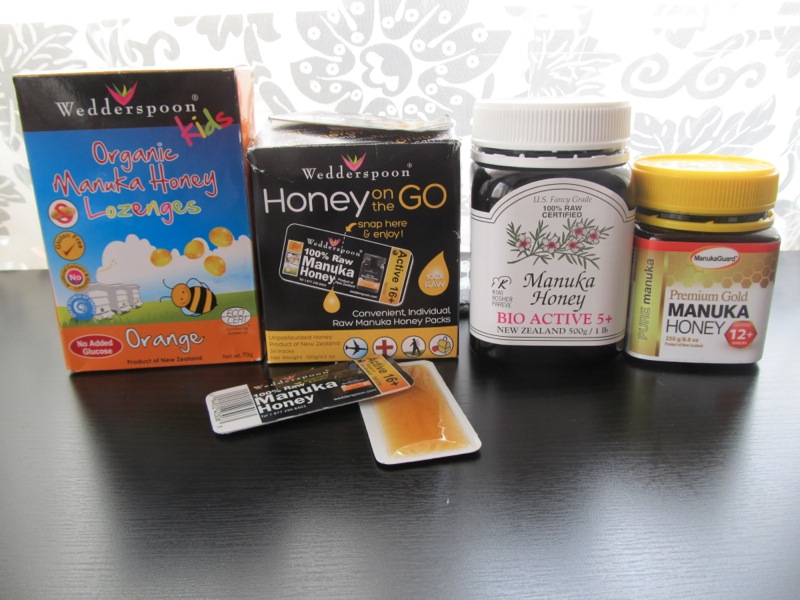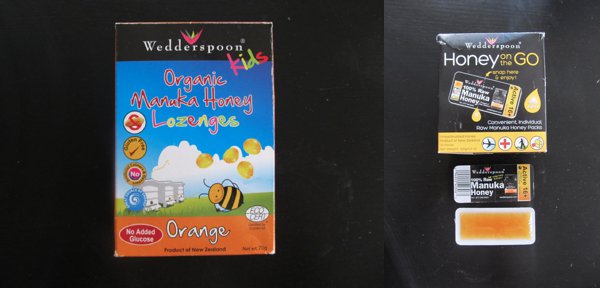Manuka honey, what does it do? Let me first start of by saying I was floored when I found out how much it cost, but was even more taken aback when I saw how fast it healed a wound. My boyfriend had a deep cut on his pinky finger, and he was in so much pain. He could barely bend it. He put the Manuka honey on it twice a day and the pain went away quickly. By the end of the week I could barely see where the cut was. If you work in a restaurant kitchen, have ever had a cut or burn, you know they can take quite some time to heal. Restaurants keep special first aid kits with burn creams, antiseptic creams, etc., but I have never seen anything as effective as this honey. Therefore paying around $30.00 for a small, 1-pound jar, ended up being well worth it!
Honey
First, let’s take a brief look at honey in general. For centuries, honey has been used for its medicinal properties. I’m sure when you got a soar throat your mother, or someone told you to try drinking hot tea with honey. When I got a little older I even heard someone say to me, mix honey with a warm shot of cognac or rum. I always laughed at this, since I grew up in a household with NO alcohol. I though people were just looking for an excuse to have a shot. However, many civilizations used honey as medicne. Ancient Egyptians used it to heal wounds and during the embalming process to help preserve the bodies.
Manuka Honey
Manuka honey is made in New Zealand and New Zealand only. The bees gather nectar from manuka plant that grows in New Zealand only. Dr. Peter Molan at The University of Waikato New Zealand, has devoted most of his career researching Manuka honey and its various healing properties. He is a professor of biochemistry. His work has pioneered most of the Manuka honey research and he has been working with many people in the medical field to understand better how it works. Check out this video of Dr. Molan explaining some of his research.
(I do not own this video nor do I claim rights to this video.)
Since our ancestors have known that honey is great to have in the medicine cabinet, what sets Manuka honey apart?
Manuka Honey has been effective against the following:
All honey has antibacterial qualities because they all contain hydrogen peroxide. Do not worry, it is completely natural and safe to consume. This is what allows honey to fight off bacteria. Manuka honey unlike any other honey, is able to fight and kill hundreds of different bacteria strains. It is also used to kill fungi. Some wounds get infected to the point where even antibiotics cannot kill the infection. Manuka honey on the other hand, has yet to be found ineffective on such wounds; hence, the reason it is found in hospitals all over New Zealand.
Manuka has also undergone research for its ability to help fight tooth decay and reduce plaque. Sounds kind of crazy, right? After all, it is sugar but once again setting this honey apart from all others. Of course I would not suggest eating half a container a day, but adding this to your tea instead of refined sugar would only help you.. The medical-grade jars of honey even have recommendations on the back for what dosage a person should take. I would consult your local physician and dentist before doing so, especially if you have diabetes. For more on Manuka and tooth decay click here.
Manuka Potency?
Dr. Peter Molan states, “In all honeys, there is – to different levels – hydrogen peroxide produced from an enzyme that bees add to the nectar. In manuka honey, and its close relative which grows in Australia called jellybush, there’s something else besides the hydrogen peroxide. It works on bacteria, fungi, protozoa. We haven’t found anything it doesn’t work on among infectious organisms. And there’s nothing like that ever been found anywhere else in the world.” Manuka Honey Manuka Honey Benefits
This “it factor,” that is not found in anything else is what Dr. Molan likes to refer to as the Unique Manuka Factor (UMF). This has now become one of the few ways to certify and authenticate the potency of Manuka honey’s antibacterial power. UMF is an international trademark, much like AOC is to French Wine for example. There are certain standers set in place to assure the quality and authenticity of a product.
UMF honey has to be produced in New Zealand and Packaged in New Zealand. Some companies are trying to ship over large barrels of Manuka honey to other countries and then packaging them abroad. When this happens some companies, not all, will alter the honey to raise the UMF active rating. When you see a jar with the UMF rating, understand that they have to pay for that certification. Some companies are too small, cannot afford to pay or choose not to pay fees to have the UMF rating on it. If it has a UMF rating it has a UMF rating of 10+ or higher. There are companies that have now made up their own verbiage or set up their own standard for evaluating the honey’s active ingredient. Either way, if it’s quality honey you are going to have to pay for it, but that’s not saying you need to spend $50 on a 8-oz jar. I suggest researching the brand before you buy and go to your local health-food store and speak to them. Some of the people working at the store have a wealth of knowledge because they speak directly to the vendors themselves.
Then you ask, what is this rating system all about? You can find ratings of Manuka honey of 5+, 10+, 12+, 16+, etc. These numbers are a way a measuring the kill zone of its UMF antibacterial property. The bigger the number the more surface area it is able to attack and kill. For healing acne, scars, wounds etc. UMF 16+ seems to be recommended by most. You can also purchase a medical grade Manuka that has undergone laboratory testing, deemed to fit various international laws. It tends to come in a smaller jar and is more expensive. There are only a few brands that make medical grade Manuka honey. Some say raw organic UMF Manuka honey does the same as the medical grade. I’m not a physician nor a scientist so I cannot say one way or the other. For my home use, UMF 16+ is just fine for my household. If I had a severe health issue, cut, burn etc. I would go to the doctor regardless.
Through my research, it appears that ratings of UMF 20+, some say 16+, and higher, are not found naturally in Manuka honey. When you start to see ratings of 20+ and beyond, companies have altered them somehow and quite often do so for marketing purposes. You will quite often find these to be more expensive, so don’t believe the hype and fall for a marketing scheme. I’ve even seen Manuka honeys mixed with glucosamine chondroitin, ginger, and other various herbs and supplements. These sell for around $50 and more. I say don’t waste your money. Buy the herbal supplement, or whatever additive that you saw in the Manuka honey, separately in it’s natural form or supplement form.
Manuka Products I love
Wedderspoon is a great company for Manuka Products and easy to find. Whole Foods carries their products and so do a variety of health food stores. Their raw organic Manuka honey is found in a clear glass bottle. I was informed that all organic Manuka honey legally has to be placed in a glass jar. Wedderspoon make great throat lozenges for children. These are recommended for kids 5 and older. They make Manuka lozenges for adults in different flavors.
Wedderspoon sells individual packets of Active 16+, Raw Manuka honey. These are great to keep in your bag/purse, when you are hiking, they even pass through airport security so you can bring them on the airplane. Going hiking? Include them as apart of your first aid kit. If you happen to burn yourself around the campfire, or scrape your knee on a rock it is conveniently packaged for you to keep in your pocket.
For those with skin problems, scars, and acne Manuka honey works wonders here. You can find face creams with the honey in it. There is a Manuka honey face mask/ face cream, found here. It is not cheap, at almost $80 a jar, but at least you don’t have to worry about putting sticky honey on your face this way.
Flavor: Eating, and Baking with Manuka Honey
The flavor of this honey is quite rich. It has a slight earthy taste and it is creamier than most other honeys. I love eating a small spoon of it, just for general health. I place it in my morning green smoothie as well as a nice cup of tea.
My work as a chef requires me at times to make sugar-free recipes, meaning no white, brown or granular sugars. I experiment a lot with baking, using agave and honey as subsitutes. As you may know, baking with honey causes baked goods to brown quickly so you have to be careful. Lowering the oven temperature about 25 degrees fahrenheit and reducing the amount of liquid, helps to prevent your baked goods from burning. Since I love Manuka I decided to experiment a little, adding Manuka honey to my baked goods. The results were not the best. Already the product is expensive so I would not suggest pouring a cup or so into cake batter. But the flavor is so pronounced that it was not very enjoyable. My advice would to be to add a very little amount if you wanted to use it in your bake goods. I prefer to recommend drizzling Manuka honey on top of yogurt or using it to garnish dishes and baked goods. Using a touch of it in a salad dressing is tasty as well.
Was this helpful?
I hope this was helpful. I tried to piece together a more comprehensive post on Manuka Honey, so you would not have to look all over the internet. If you have thoughts, comments, or testimonies about Manuka honey please share below.
I am not a medical doctor nor do I claim to be one. Consult your doctor before before starting your own medical regiment. Do not give honey to children that are under the age of 2, consult a doctor when giving honey to children.
Articles and more information:
BBC’s Harnessing honey’s healing power
Green Bay: Real Food For Better Being




